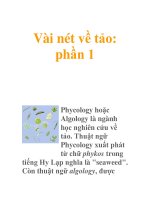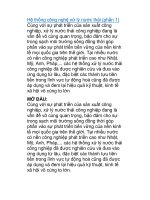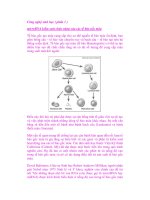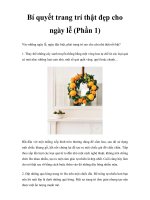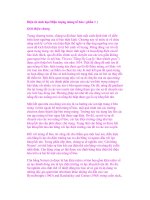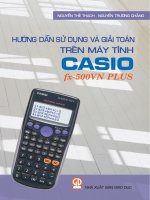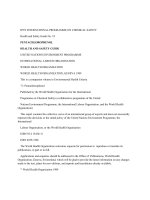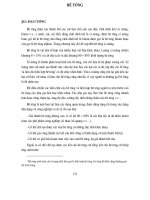Light Measurement Handbook phần 1 ppsx
Bạn đang xem bản rút gọn của tài liệu. Xem và tải ngay bản đầy đủ của tài liệu tại đây (2.5 MB, 10 trang )
HTTP://www.intl-light.com/handbook/
2
Light Measurement Handbook © 1998 by Alex Ryer, International Light Inc.
To receive International Light's
latest Light Measurement
Instruments Catalog, contact:
International Light
17 Graf Road
Newburyport, MA 01950
Tel: (978) 465-5923 • Fax: (978) 462-0759
•
Copyright © 1997 by Alexander D. Ryer.
All Rights Reserved.
No part of this publication may be reproduced or transmitted in any form or by any means, electronic
or mechanical, including photocopying, recording, or any information storage and retrieval system,
without permission in writing from the copyright owner. Requests should be made through the
publisher.
Technical Publications Dept.
International Light, Inc.
17 Graf Road
Newburyport, MA 01950-4092
ISBN 0-9658356-9-3
Library of Congress Catalog Card Number: 97-93677
Second Printing
Printed in the United States of America.
3
Light Measurement Handbook © 1998 by Alex Ryer, International Light Inc.
Contents
1 What is Light? 5
Electromagnetic Wave Theory 5
Ultraviolet Light 6
Visible Light 7
Color Models 7
Infrared Light 8
2 The Power of Light 9
Quantum Theory 9
Flat Response 10
Visible Light 11
Effective Irradiance 12
3 How Light Behaves 13
Reflection 13
Transmission: Beer-Lambert or Bouger’s Law 14
Refraction: Snell’s Law 15
Diffraction 16
Interference 16
4 Manipulating Light 17
Diffusion 17
Collimation 17
Transmission Losses 18
Focusing Lenses 18
Mirrors 19
Concave Mirrors 19
Internal Transmittance 20
Prisms 20
Diffraction Gratings 20
5 Light Sources 21
Blackbody Radiation 21
Incandescent Sources 22
Luminescent Sources 23
Sunlight 24
6 Basic Principles 25
The Inverse Square Law 25
Point Source Approximation 26
Lambert’s Cosine Law 27
Lambertian Surface 28
4
Light Measurement Handbook © 1998 by Alex Ryer, International Light Inc.
7 Measurement Geometries 29
Solid Angles 29
Radiant and Luminous Flux 30
Irradiance and Illuminance: 32
Cosine Law 32
Calculating Source Distance 33
Radiance and Luminance: 34
Irradiance From An Extended Source: 35
Radiant and Luminous Intensity: 36
Converting Between Geometries 38
8 Setting Up An Optical Bench 39
A Baffled Light Track 39
Kinematic Mounts 40
9 Graphing Data 41
Line Sources 41
Polar Spatial Plots 42
Cartesian Spatial Plots 43
Logarithmically Scaled Plots 44
Linearly Scaled Plots 45
Linear vs. Diabatie Spectral Transmission Curves 46
10 Choosing a Detector 47
Sensitivity 47
Silicon Photodiodes 48
Solar-Blind Vacuum Photodiodes 49
Multi-Junction Thermopiles 50
11 Choosing a Filter 51
Spectral Matching 51
12 Choosing Input Optics 55
Cosine Diffusers 56
Radiance Lens Barrels 57
Fiber Optics 58
Integrating Spheres 58
High Gain Lenses 58
13 Choosing a Radiometer 59
Floating Current to Current Amplification 60
Transimpedance Amplification 61
Integration 62
Zero 62
14 Calibration 63
References 64
5
Light Measurement Handbook © 1998 by Alex Ryer, International Light Inc.
1 What is Light?
Electromagnetic Wave Theory
Light is just one portion of the various electromagnetic waves flying
through space. The electromagnetic spectrum covers an extremely broad range,
from radio waves with wavelengths of a meter or more, down to x-rays with
wavelengths of less than a billionth of a meter. Optical radiation lies between
radio waves and x-rays on the spectrum, exhibiting a unique mix of ray, wave,
and quantum properties.
At x-ray and shorter wavelengths, electromagnetic radiation tends to be
quite particle like in its behavior, whereas toward the long wavelength end of
the spectrum the behavior is mostly wavelike. The visible portion occupies
an intermediate position, exhibiting both wave and particle properties in
varying degrees.
Like all electromagnetic waves, light waves can interfere with each other,
become directionally polarized, and bend slightly when
passing an edge. These properties allow light to be filtered
by wavelength or amplified coherently as in a laser.
In radiometry, light’s propagating wavefront is
modeled as a ray traveling in a straight line. Lenses and
mirrors redirect these rays along predictable paths. Wave
effects are insignificant in an incoherent, large scale optical
system because the light waves are randomly distributed and
there are plenty of photons.
6
Light Measurement Handbook © 1998 by Alex Ryer, International Light Inc.
Ultraviolet Light
Short wavelength UV light exhibits more quantum properties than its
visible and infrared counterparts. Ultraviolet light is arbitrarily broken down
into three bands, according to its anecdotal effects.
UV-A is the least harmful and most commonly found type of UV light,
because it has the least energy. UV-A light is often called black light, and is
used for its relative harmlessness and its ability to cause fluorescent materials
to emit visible light - thus appearing to glow in the dark. Most phototherapy
and tanning booths use UV-A lamps.
* Definitions
based on
biological
effect.
UV-B is typically the most destructive form of UV light, because it has
enough energy to damage biological tissues, yet not quite enough to be
completely absorbed by the atmosphere. UV-B is known to cause skin cancer.
Since most of the extraterrestrial UV-B light is blocked by the atmosphere, a
small change in the ozone layer could dramatically increase the danger of
skin cancer.
Short wavelength UV-C is almost completely absorbed in air within a
few hundred meters. When UV-C photons collide with oxygen atoms, the
energy exchange causes the formation of ozone. UV-C is almost never observed
in nature, since it is absorbed so quickly. Germicidal UV-C lamps are often
used to purify air and water, because of their ability to kill bacteria.
7
Light Measurement Handbook © 1998 by Alex Ryer, International Light Inc.
Visible Light
Photometry is concerned with the measurement of optical radiation as it
is perceived by the human eye. The CIE 1931 Standard Observer established
a standard based on the average human eye response under normal illumination
with a 2° field of view. The tristimulus values graphed below represent an
attempt to describe human color recognition using three sensitivity curves.
The y(λ) curve is identical to the CIE V(λ) photopic vision function. Using
three tristimulus measurements, any color can be fully described.
Color Models
Most models of perceived color
contain three components: hue,
saturation, and lightness. In the CIE
L*a*b* model, color is modeled as a
sphere, with lightness comprising the
linear transform from white to black, and
hues modeled as opposing pairs, with
saturation being the distance from the
lightness axis.
8
Light Measurement Handbook © 1998 by Alex Ryer, International Light Inc.
Infrared Light
Infrared light contains the least amount of energy per photon of any
other band. Because of this, an infrared photon often lacks the energy required
to pass the detection threshold of a quantum detector. Infrared is usually
measured using a thermal detector such as a thermopile, which measures
temperature change due to absorbed energy.
While these thermal detectors have a very flat spectral responsivity, they
suffer from temperature sensitivity, and usually must be artificially cooled.
Another strategy employed by thermal detectors is to modulate incident light
with a chopper. This allows the detector to measure differentially between
the dark (zero) and light states.
Quantum type detectors are often used in the near infrared, especially
below 1100 nm. Specialized detectors such as InGaAs offer excellent
responsivity from 850 to 1700 nm. Typical silicon photodiodes are not sensitive
above 1100 nm. These types of detectors are typically employed to measure
a known artificial near-IR source without including long wavelength
background ambient.
Since heat is a form of infrared light, far infrared detectors are sensitive
to environmental changes - such as a person moving in the field of view.
Night vision equipment takes advantage of this effect, amplifying infrared to
distinguish people and machinery that are concealed in the darkness.
Infrared is unique in that it exhibits primarily wave properties. This can
make it much more difficult to manipulate than ultraviolet and visible light.
Infrared is more difficult to focus with lenses, refracts less, diffracts more,
and is difficult to diffuse. Most radiometric IR measurements are made without
lenses, filters, or diffusers, relying on just the bare detector to measure incident
irradiance.
9
Light Measurement Handbook © 1998 by Alex Ryer, International Light Inc.
2 The Power of
Light
Quantum Theory
The watt (W), the fundamental unit of optical power, is defined as a rate
of energy of one joule (J) per second. Optical power is a function of both the
number of photons and the wavelength. Each photon carries an energy that is
described by Planck’s equation:
Q = hc / l
where Q is the photon energy (joules), h is Planck’s constant (6.623 x
10
-34
J s), c is the speed of light (2.998 x 10
8
m s
-1
), and λ is the wavelength of
radiation (meters). All light measurement units are spectral, spatial, or
temporal distributions of optical energy. As you can see in figure 2.1, short
wavelength ultraviolet light has much more energy per photon than either
visible or long wavelength infrared.
10
Light Measurement Handbook © 1998 by Alex Ryer, International Light Inc.
Flat Response
Since silicon photodiodes are more sensitive to light at the red end of
the spectrum than to light at the blue end, radiometric detectors filter the
incoming light to even out the responsivity, producing a “flat response”. This
is important for accurate radiometric measurements, because the spectrum of
a light source may be unknown, or may be dependent on operating conditions
such as input voltage.
Most sources are continuums, emitting over a broad band of the spectrum.
Incandescent lamps are a good example. The color temperature and output of
these lamps vary significantly with input voltage. Flat response detectors
measure only output power in watts, taking into consideration light at every
wavelength.
Another approach is to use a narrow band filter to measure only within
a small wavelength band. This is acceptable if the lamp has been fully
characterized and the color temperature is carefully monitored. The difficulty
with narrow band measurements, however, is that they only look at a single
wavelength. If, for example, the color temperature of a lamp changes, it
means that the energy distribution has shifted to a different peak wavelength.
Single wavelength measurements do not reflect the total output power of the
source, and may mislead you into adjusting the source.
Ratios between two narrow bands are quite useful, however, in
monitoring color temperature. By measuring the red to blue ratio of a lamp,
you can carefully monitor and adjust its spectral output.
